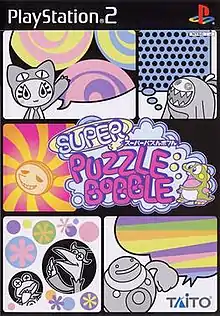Super Puzzle Bobble
Super Puzzle Bobble, released as Super Bust-A-Move in Europe and North America, is a puzzle video game in the Puzzle Bobble series. It was developed by Taito, and released on November 26, 2000 by Acclaim Entertainment for the PlayStation 2 and Windows. It was later ported to the Game Boy Advance on November 27, 2001. It was re-released in Japan for the PlayStation 2 in 2004 as part of Super Puzzle Bobble DX (along with its sequel, Super Puzzle Bobble 2), which is Volume 62 of the Japan-exclusive Simple 2000 Series. This compilation includes a few graphical enhancements.
| Super Puzzle Bobble | |
|---|---|
 Japanese PlayStation 2 cover art | |
| Developer(s) | Taito Altron (GBA version) |
| Publisher(s) | Taito
|
| Series | Puzzle Bobble |
| Platform(s) | PlayStation 2 Windows Game Boy Advance GameCube |
| Release | PlayStation 2 Game Boy Advance Windows
|
| Genre(s) | Puzzle |
| Mode(s) | Single-player, multiplayer |
Super Puzzle Bobble was ported to the GameCube in 2003, under the name of Super Puzzle Bobble All-Stars in Japan, Super Bust-A-Move All-Stars in Europe, and Bust-A-Move 3000 in North America. The game is a direct port, except for the inclusion of new backgrounds and remixed music. It also features new box artwork, more in line with the in-game artwork.
It is the first mainstream game in the series not to see an arcade release, although there is an arcade game with the same title, which is a completely different game to this one.
Gameplay
Super Puzzle Bobble gameplay is essentially the same as the rest of the series. It bestows some audiovisual improvements, adds and removes gameplay elements, adds a new art style, and adds a new character roster. It has single player, training, computer competition, and two player competition modes. New to this game are large-sized bubbles and a two player cooperation mode, in which players work together to solve a stage.[4]
The GameCube All-Stars version has a four player option and a Space Invaders-style mode called "Shoot Bubble".[5]
Reception
Critical reception
| Aggregator | Score |
|---|---|
| GameRankings | 60.75% (GameCube)[6] |
| Metacritic | 53% (GameCube)[3] |
| Publication | Score |
|---|---|
| AllGame | |
| CVG | 8/10 (GBA)[9] |
| GameSpot | 5.4/10 (PS2)[10] 5/10 (GameCube)[11] |
| Next Generation | |
| NGC Magazine | 70%[5] |
| PSM | 8/10 (PS2)[13] |
Ryan Davis of GameSpot said the PS2 version of the game has the best graphics and sound of the series to date, "with extraordinarily sharp 2D graphics and a healthy amount of visual splendor", but that its gameplay represents an "incredibly stripped-down" disappointment to the series which "brings virtually nothing new to the franchise" and is missing a lot of features from the previous year's Bust-a-Move 4.[10] As for the GameCube version, there was nothing new and the analog controls were awkward, but the multiple gameplay modes kept players happy.[11] A reviewer on NGC Magazine regarded the game as worth owning, but only on one console.[5] A reviewer on Next Generation found the game a bit disappointing and no different from the original game.[12]
Promotion
The game was showcased at the February 1999 AOU Amusement Expo in Japan.[14]
References
- B. Fiechter (November 2000). "all-format Previews". Gamers' Republic. No. 30. Millenium Publications. p. 58.
- "Gameshark Calendar". GameShark. IGN.com. November 2001. p. 14.
- "Bust-A-Move 3000 (GameCube) - Metacritic". Metacritic. Retrieved November 15, 2019.
- "Taito goes by the Competition". Gamers' Republic. No. 12. Millenium Publications. May 1999. p. 34.
- Evans, Geraint (January 2004). "Super Bust-A-Move All Stars". NGC Magazine. No. 89. Future plc. p. 50.
- "Bust-A-Move 3000 (GameCube) - GameRankings". GameRankings. Retrieved November 15, 2019.
- Miller, Skyler. "Super Bust-A-Move". AllGame. Archived from the original on November 14, 2014. Retrieved October 15, 2020.
- Thompson, Jon. "Super Bust-A-Move". AllGame. Archived from the original on November 14, 2014. Retrieved October 15, 2020.
- Skittrell, Lee (December 29, 2001). "Super Bust-a-Move". Computer and Video Games. Archived from the original on July 17, 2007. Retrieved October 15, 2020.
- Davis, Ryan (November 30, 2000). "Super Bust-A-Move Review". GameSpot. Retrieved August 15, 2016.
- Davis, Ryan (April 21, 2003). "Bust-A-Move 3000 Review". GameSpot. Retrieved November 15, 2019.
- Russo, Tom (December 2000). "ng Review - Super Puzzle Bobble". Next Generation. No. 72. Imagine Media. p. 105.
- "PSM Honor Roll". PlayStation: The Official Magazine. No. 55. Future plc. February 2002. p. 53.
- "AOU Show Preview". Gamers' Republic. No. 11. Millenium Publications. April 1999. p. 11.
